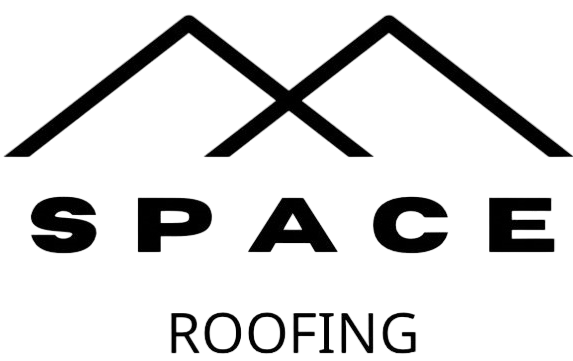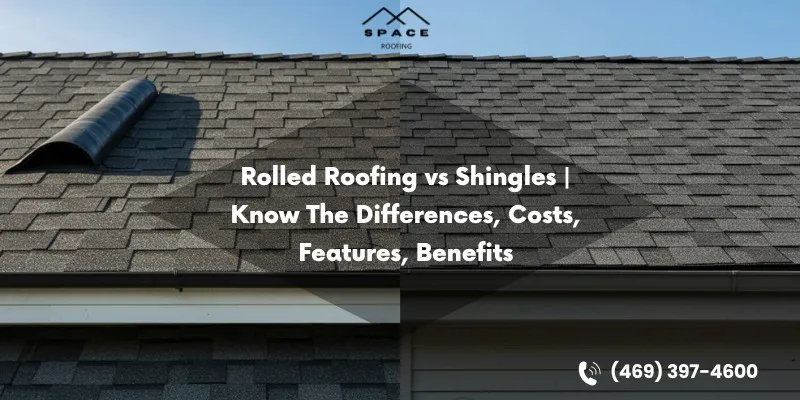When you are stare at a tired old roof or map out your dream shed, you will face a surprisingly important decision: rolled roofing vs shingles. The choice isn’t just about appearances, it is about durability, long-term value, and how much effort you are willing to invest.
The key to making the right investment is knowing the pros and cons of shingles vs rolled roofing. Understanding the properties of both materials can help you avoid costly repairs and regrets.
Rolled Roofing vs Shingles
A showdown of material, durability, and design, shingles vs roll roofing is the classic debate for budget-conscious and functionality-focused roofing projects. The right choice hinges on where you live, the pitch of your roof, and what kind of finish you are after.
1. Differences
Let’s explore how roof shingles vs rolled roofing differ side-by-side:
- Material: Shingles are typically made from fiberglass or composite bases with asphalt and ceramic coating. Rolled roofing is a rolled asphalt material, like a giant roofing carpet, ideal for quick fixes and temporary structures.
- Installation: Shingles go down piece by piece, which takes time but allows for detailed work and visual consistency. Asphalt roll application is quicker and great for covering a roof fast without specialized tools.
- Durability: Shingles are thicker and layered, making them resistant to wind and hail. Durable shingles roll options are better under stress, but rolled roofing tends to wear faster under harsh weather conditions.
- Appearance: Shingles offer a textured, attractive finish that boosts home value. Rolled roofing is flat and utilitarian, mostly seen on sheds or garages.
- Roof Slope: Shingles need steeper slopes to drain water well, while roll shingles flat roof applications excel on low-pitch or flat roofs that would otherwise pool water.
- Usage: Shingles are residential favorites due to their aesthetic appeal. Rolled roofing is more common for non-living spaces or budget-limited structures.
- Repair: Damaged shingles can be individually replaced, keeping maintenance costs low. Rolled roofing might need full patching or reapplication over larger areas, primarily if cracks spread.
- Weight: Rolled roofing is lighter and easier to move, a big plus for solo projects or areas hard to reach with heavy bundles of shingles.
2. Costs
Rolled roofing is the more economical option, perfect for those seeking affordable roll roofing shingles. It typically costs between $1.50–$2.50 per square foot installed, compared to shingles, which range from $3.50–$5.50 per square foot installed. Some high-end architectural shingles cost up to $6.50 per square foot.
With rolled roofing, you save on labor and materials but might be trading off longevity. While rolled roofing’s life expectancy is around 5 to 10 years, shingles last 20–30 years, depending on the brand and maintenance. So, while the upfront cost is lower with rolled options, shingles could prove a smarter long-term investment that enhances your property value.
3. Features
-
Design Options
- Shingles are available in numerous styles, textures, and colors for maximum curb appeal. You can match shingles to any architectural style, from rustic wood tones to sleek, modern finishes.
- Rolled Roofing is typically limited to basic black or grey, less decorative but more utilitarian, and often used for purely functional builds.
-
Size & Coverage:
- Shingles come in bundles; they need more installation time and require aligning each piece with care.
- A roll of roofing material covers about 100 square feet, ideal for speed and efficiency during urgent projects or when covering large flat areas.
-
Weight & Handling:
- Shingles are heavier and bulkier, and carrying up a ladder or moving around on a steep roof can be challenging.
- Rolled Roofing is lightweight and easy for DIY use, with most rolls weighing under 90 pounds.
-
Flexibility:
- Shingles are rigid, great for standard roof shapes, and ideal for buildings where visual appeal matters.
- Rolled Roofing is a flexible roofing roll asphalt, perfect for odd corners, curved surfaces, or quick fixes around chimneys and vents.
-
Repair & Maintenance:
- Shingles can easily isolate and replace a few damaged pieces without disrupting the entire roof.
- Rolled Roofing requires patching or replacing larger sections, and seams must be sealed carefully to prevent leaks.
-
Compatibility:
- Shingles are ideal for steep-slope roofs where water runoff is fast.
- Rolled Roofing is better for flat roof asphalt roll roofing setups or low-slope surfaces like porches, sheds, and workshops.
4. Benefits
-
Installation Speed:
- Rolled Roofing is much faster to apply, especially when time is limited or weather conditions are unpredictable.
- Shingles set slower and require precision, but each piece contributes to a stronger, layered finish.
-
Affordability:
- Rolled Roofing is ideal for those on tight budgets or quick fixes where appearances don’t matter.
- Shingles have a higher initial investment but a better long-term return, especially with premium lines that last decades.
-
DIY-Friendly:
- Rolled Roofing is beginner-friendly; if you can roll a carpet, you can install basic roofing.
- Shingles require more tools, effort, and some experience to ensure proper alignment and sealing.
-
Curb Appeal:
- Shingles add beauty and resale value to homes, which is often required in residential zones due to aesthetic regulations.
- Rolled Roofing function over form is mainly used where looks aren’t prioritized.
-
Longevity:
- Shingles last 20–30 years on average; some products go beyond 40 with warranties.
- Rolled Roofing lasts 5–10 years (rolled asphalt roofing life expectancy), depending on climate and installation.
-
Energy Efficiency:
- Most shingles reflect sunlight and reduce attic temperatures, especially cool-roof-certified varieties.
- Rolled Roofing offers less insulation but can be upgraded with reflective coatings.
5. Disadvantages
-
Lifespan:
- Rolled Roofing has a shorter rolled roof life expectancy, generally under 10 years.
- Shingles have been longer-lasting and more resilient over the decades.
-
Appearance:
- Rolled Roofing lacks style.
- Shingles are more attractive and suitable for visible residential spaces.
-
Durability:
- Rolled Roofing is prone to cracks and tears from temperature swings.
- Shingles are strong against weather and reinforced by granule coating.
-
Cost & Time:
- Rolled Roofing is cheaper and faster but may require more frequent replacement.
- Shingles are pricier and more labor-intensive but a one-time investment for decades.
Space Roofing | Best Roofing Contractor In Dallas
The rolled roofing choice is ideal for quick, low-budget projects, while shingles promise beauty and longevity. Ultimately, it is about matching the roof to your lifestyle, location, and long-term plans. If you are looking for something temporary or need to waterproof a shed, rolled asphalt roofing material can be a lifesaver. But if you build a home to last, nothing beats the reliability and charm of asphalt shingle roll.
For any roof, finding the proper roofing manufacturer can help you pick the product that meets your needs without compromising on quality.
Choosing between shingles in a roll or a full roll shingle roof? Space Roofing in Dallas is the expert you need. They have mastered every roofing system—roofing asphalt roll, rolled roofing shingles, or high-end asphalt shingle roofing roll installations.
Space Roofing understands whether you need function or flair and guides you accordingly. Trust a contractor who knows the difference between shingles vs rolled roofing inside and out. Visit Space Roofing to get your free quote today!
FAQs
1. What is the main difference between rolled roofing and shingles?
Rolled roofing is a continuous asphalt material ideal for quick, low-cost installs, while shingles are individual asphalt pieces layered for better aesthetics, durability, and longevity on residential buildings.
2. Which roofing option lasts longer, rolled roofing or shingles?
Shingles typically last 20–30 years or more, depending on quality and upkeep, while rolled roofing usually has a lifespan of just 5–10 years, making shingles better for long-term value.
3. Is rolled roofing suitable for homes?
Rolled roofing is best for temporary or non-living structures like sheds and garages. It lacks the visual appeal and longevity required for residential homes, making shingles a better choice.
4. Are shingles worth the extra cost over rolled roofing?
Yes, shingles have a higher upfront cost but offer better curb appeal, stronger durability, and longer lifespan, often saving money in the long run through reduced repairs and improved property value.
5. Can I install rolled roofing or shingles by myself?
Rolled roofing is more DIY-friendly due to its lightweight and simple application. Shingles require more tools, skill, and time for proper alignment and sealing, often needing professional installation.


